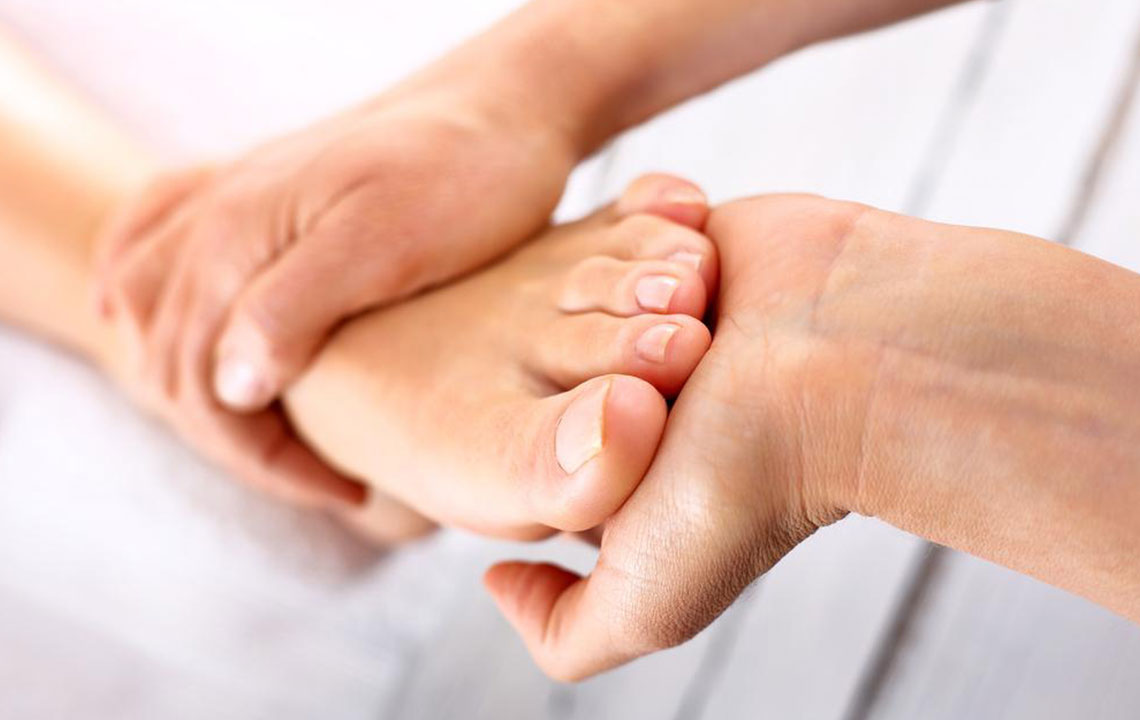Causes and Relief Measures for Toe Pain

Toe pain has many causes. Since there are many joints in these small digits, any injury can cause acute pain. It is important to find the causes of the pain, before picking the right treatment.
Causes of Toe Pain
Toe pain can result from a direct injury like a stubbed toe, or it can be the symptom or effect, or other disorders.
Gout
Gout is caused by high levels of uric acid in the body, which results in the formation of urate crystals. These crystals can get accumulated in the foot and toe joints, causing swelling, redness, and sudden intense pain.
Bunion
This is a condition that causes deformation of the big toe and results in pain and discomfort. The big toe pushes against the next toe. Eventually, the top of the big toe turns inwards, while the bottom part is pushed out. The most common cause is by wearing shoes that squash the toes.
Deformation in Other Toes
Each toe in the foot has three joints. The exception is the big toe which has two. Besides bunion, you can also suffer from other toe misalignments like:
Hammer Toe: The middle joint in the toe bends down, and pushes that joint up. This commonly occurs in the second toe.
Claw Toe: The end and middle joints in the toe bend, and cause curling of the toe, and it is a painful condition. It often affects multiple toes.
Mallet Toe: The top joint or distal joint, bend down. This prevents you from stretching the toe as you walk, and causes pain.
Tennis Toe and Turf Toe
These two conditions often affect sportsmen and others, who indulge in activities that cause constant shock and stress to the feet. Tennis toe is caused by the frequent slamming of the toes against the front edge of the shoes, that you are wearing. Turf toe is caused when the big toe is stretched backward beyond a limit. This sudden hyperextension damages your ligaments and causes pain.
Ingrown Toenails
This often affects the big toe. The curved sides of the nail penetrate the skin and causes pain and swelling. This condition can lead to infection and other complications.
Morton’s Neuroma
Morton’s neuroma is caused, when the tissues around the nerves that run between the toes, thicken and adds stress on the nerves. This can also be caused by other foot conditions like bunions, hammer toes, or flat feet.
Sesamoiditis
Sesamoid bones are two pea-shaped bones beneath the big toe. They play an important role in the mobility and flexibility of the big toe. When the area around the sesamoid bones become inflamed, it causes toe pain and inhibits the movement of the big toe.
Arthritis
Arthritis affects all joints. The most commonly affected part of the feet if you have arthritis is the base of the big toe. The cartilage that lines this region gets damaged, resulting in the stiffening of the toe.
Of course, toe pain may also have other causes such as blisters, stubbed toe, toe fracture, and leakage of blood vessels in the foot.
Toe Pain Relief
Toe pain can be treated once you know the cause. Following are some of the treatments, based on the causes.
Bunion and Other Toe Deformities
Bunions, mallet toes and similar conditions can be treated with stretching exercises, painkillers, wearing the right fit and type of footwear. You should not wear footwear that stretches or squashes the toes.
Tennis and Turf Toes
Tennis toe results in injured nails and toes. Clean the area and apply an antiseptic cream, cover with a dressing. If the injury is severe, visit the doctor. To prevent this condition from recurring, clip your toenails and choose proper footwear, that provides padding and freedom of movement for the toes.
For turf toe, you have to give it time to heal. Complete rest from stressful activities helps heal the injured ligaments and your feet recovers sooner.
Morton’s Neuroma
Morton’s Neuroma can be treated with painkillers, rest, orthotics or special insertions in your shoes, and in rare cases, surgery.
Arthritic Toe Pain
For this condition, you need to take pain medication, use hot or cold compress, Epsom salt foot soak, gentle exercises, and in severe cases, steroid injections or even surgery.
Sesamoiditis
For this condition that affects the big toes, you can try rest, pain medication, and ice treatment. Use padded comfortable shoes to avoid stressing the sesamoid bones. If the pain is severe and refuses to go away, using steroid injections is advised.
Other Remedies
For stubbed toe, arthritic pain, and other constant pain, you can try common home remedies that are used to treat foot pain:
Soak your feet alternately in hot and cold water.
Fill a small tub with hot water, add two tablespoons of vinegar to it. Soak your feet in this water for around 20 minutes.
Cayenne pepper contains capsaicin which provides relief from aches and pains. Try adding a teaspoon of powdered cayenne pepper to a hot water bucket, then soak your feet in it for a sometime.
Put some crushed ice in a plastic bag and massage the painful area in a circular motion. The ice helps to numb the region, and it also helps to reduce swelling. Do not apply this ice pack for longer than 10 minutes.
Add two or three tablespoons of Epsom salt to warm water in a tub, and soak your feet for a few minutes.
Massage your feet or toes gently with clove oil, to get quick relief from pain. If there is a cut or other open wound in the area, dilute the clove oil with olive or coconut oil, and massage the area.
There are many ways to get Toe Pain Relief. Some conditions like tennis toe and bunions need specific treatments, while arthritic pain, stubbed toes, and other toe pain conditions can be treated with common home remedies like various foot soaks and massages.


